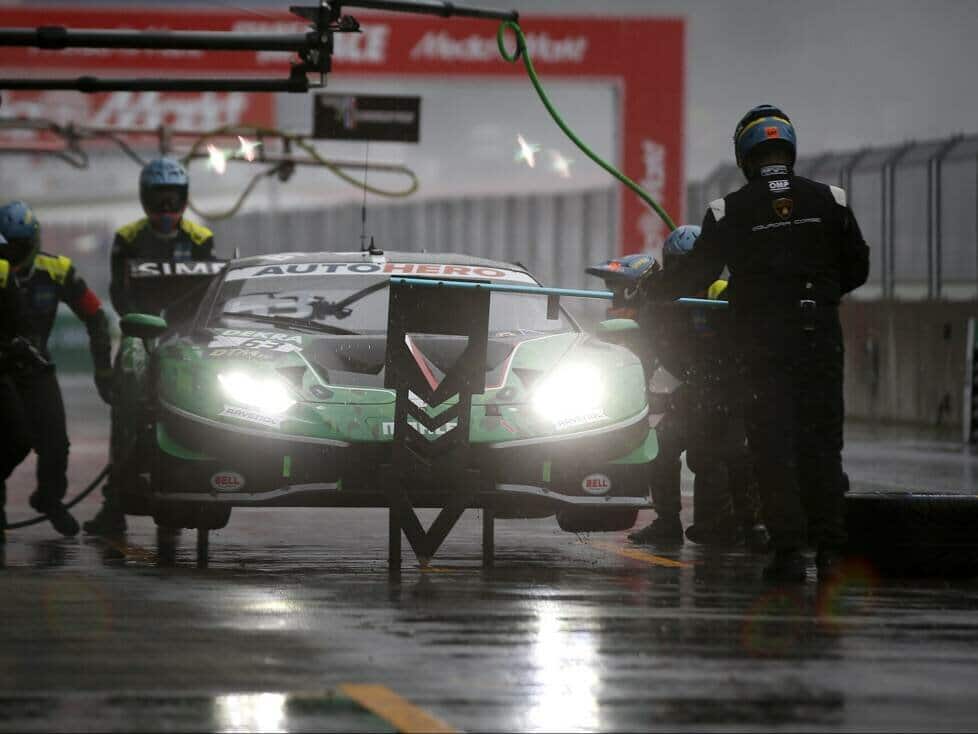Why Mirko Bortolotti’s Grasser team fears heavy rain, why they suspect the weight distribution and what it looks like for the other GT3 cars
At the moment, it doesn’t look like a rainy DTM finale at Hockenheim, but the danger has not been completely banished, especially on Saturday, with a 40 per cent chance of rain. And there is one title candidate who definitely does not need these conditions: Lamborghini works driver Mirko Bortolotti.
Because his Grasser team is suffering this season, especially in heavy rain. “Aquaplaning is an issue with us,” “We’re fine when braking and cornering, but when there’s too much water we struggle due to flotation.”
This was particularly evident in Sunday’s qualifying in Spielberg, where Mirko Bortolotti didn’t even take to the track at the end due to the conditions and only finished 22nd – with Clemens Schmid the best Lamborghini driver starting from 18th place.
Grasser: “Had really wild problems “
“We had really wild problems at the Red Bull Ring,” Grasser revealed. “More than expected – and especially compared to the others. It would have been cool if we could have tested it now,” he admits of the rain they had hoped for at Wednesday’s Hockenheim test. “But we don’t have the weather gods under control.”
Where team boss Grasser, who is also an engineer and helped develop the Huracan GT3, locates the cause? “Difficult to judge, because we couldn’t test it,” he says.
“But you could see that one Lambo and one Audi had a bit more problems than others. And our cars are also the ones with the least weight on the front axle,” he speculates that the weight distribution of the two mid-engined cars, which have the same base, could be a disadvantage when there is a lot of water on the track. “It certainly doesn’t help in that respect,” Grasser said.
Does Huracan weight distribution lead to aquaplaning?
The Lamborghini Huracan GT3 Evo and the Audi R8 LMS GT3 Evo II have a weight distribution of 43:57 percent. The lighter weight on the front axle means that sometimes you struggle to get the front tyres up to temperature. Grasser also believes that this makes the front tyres float up more easily in standing water.
“It’s a guess that it’s because we have less weight at the front than others,” he says. “Of course, it’s difficult to change that because I can’t add weight. But you can try to change it a little bit in the details.”
But the Austrian is not sure if that is the main reason. “You also have to look at everything else: Correct air pressure, correct spring settings, the camber values. That would have been very interesting during the test. We were relatively strong in the rain at the Hockenheim test in the spring. But at the Red Bull Ring, we had an extremely hard time in the extreme conditions. “
This is how the weight distribution of the DTM cars looks like
What does the weight distribution look like in the competition? While it is 43:57 per cent for the Lamborghini and the Audi, it is actually a little more centralised for the front-engined bolides: For the Mercedes-AMG GT3 it is 49:51 per cent, for the BMW M4 GT3 even 50:50 per cent.
In the Ferrari 488 GT3 Evo, too, it is somewhat more front-heavy (46:54 percent) than in the Lamborghini or the Audi, even though it is also a mid-engined car. In the Porsche 911 GT3 R, however, which has a rear-mounted engine, it is more rear-heavy than in any other DTM car at 41:59 per cent.
Timo Bernhard sees other reasons for aquaplaning
As you can see with the Porsche, a rear-heavy weight distribution is even usually considered an advantage in the rain because it’s the best way to get the power onto the asphalt. “We certainly have better traction because of our weight distribution,” confirms team boss Timo Bernhard.
“Because of aquaplaning, I think a few factors play a role: downforce, set-up, air pressure and so on. Besides, you can also float up on the rear axle.” In addition, it is clear that “at a certain water level you simply can’t drive any more.”
Grasser is nevertheless convinced: “Our weight distribution does not help in these conditions. So we hope for dry conditions – or rain with normal water. Otherwise we will always have our problems. We can’t get around that. “





